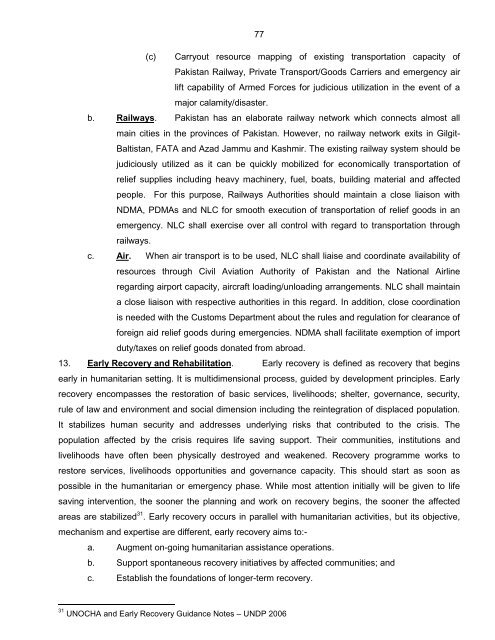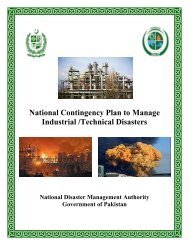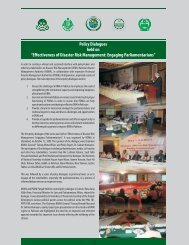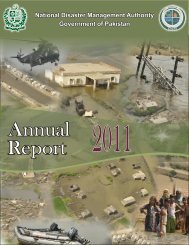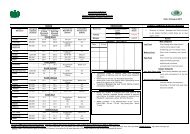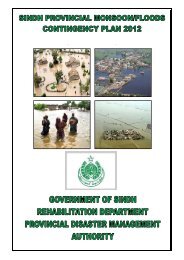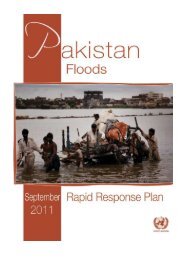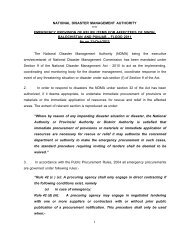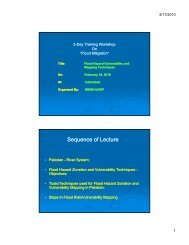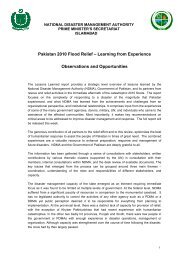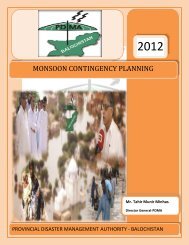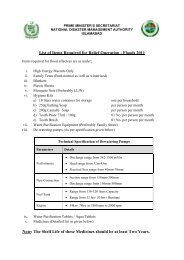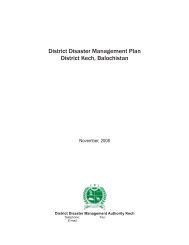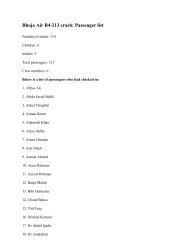National Disaster Response Plan (NDRP) March 2010 - NDMA
National Disaster Response Plan (NDRP) March 2010 - NDMA
National Disaster Response Plan (NDRP) March 2010 - NDMA
Create successful ePaper yourself
Turn your PDF publications into a flip-book with our unique Google optimized e-Paper software.
77<br />
(c) Carryout resource mapping of existing transportation capacity of<br />
Pakistan Railway, Private Transport/Goods Carriers and emergency air<br />
lift capability of Armed Forces for judicious utilization in the event of a<br />
major calamity/disaster.<br />
b. Railways. Pakistan has an elaborate railway network which connects almost all<br />
main cities in the provinces of Pakistan. However, no railway network exits in Gilgit-<br />
Baltistan, FATA and Azad Jammu and Kashmir. The existing railway system should be<br />
judiciously utilized as it can be quickly mobilized for economically transportation of<br />
relief supplies including heavy machinery, fuel, boats, building material and affected<br />
people. For this purpose, Railways Authorities should maintain a close liaison with<br />
<strong>NDMA</strong>, PDMAs and NLC for smooth execution of transportation of relief goods in an<br />
emergency. NLC shall exercise over all control with regard to transportation through<br />
railways.<br />
c. Air. When air transport is to be used, NLC shall liaise and coordinate availability of<br />
resources through Civil Aviation Authority of Pakistan and the <strong>National</strong> Airline<br />
regarding airport capacity, aircraft loading/unloading arrangements. NLC shall maintain<br />
a close liaison with respective authorities in this regard. In addition, close coordination<br />
is needed with the Customs Department about the rules and regulation for clearance of<br />
foreign aid relief goods during emergencies. <strong>NDMA</strong> shall facilitate exemption of import<br />
duty/taxes on relief goods donated from abroad.<br />
13. Early Recovery and Rehabilitation. Early recovery is defined as recovery that begins<br />
early in humanitarian setting. It is multidimensional process, guided by development principles. Early<br />
recovery encompasses the restoration of basic services, livelihoods; shelter, governance, security,<br />
rule of law and environment and social dimension including the reintegration of displaced population.<br />
It stabilizes human security and addresses underlying risks that contributed to the crisis. The<br />
population affected by the crisis requires life saving support. Their communities, institutions and<br />
livelihoods have often been physically destroyed and weakened. Recovery programme works to<br />
restore services, livelihoods opportunities and governance capacity. This should start as soon as<br />
possible in the humanitarian or emergency phase. While most attention initially will be given to life<br />
saving intervention, the sooner the planning and work on recovery begins, the sooner the affected<br />
areas are stabilized 31 . Early recovery occurs in parallel with humanitarian activities, but its objective,<br />
mechanism and expertise are different, early recovery aims to:-<br />
a. Augment on-going humanitarian assistance operations.<br />
b. Support spontaneous recovery initiatives by affected communities; and<br />
c. Establish the foundations of longer-term recovery.<br />
31 UNOCHA and Early Recovery Guidance Notes – UNDP 2006


